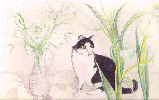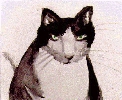
Return To Index

Leonardo da Vinci said that 'the small feline is a masterpiece' but the Australian Government is not quite so sure. A recent report suggested that the country's 21 million feral and domestic cats were decimating the native wildlife, killing 3 million native animals each year. A politician's suggestion that the entire cat population should be exterminated by the year 2020 caused an uproar, hitting the headlines in the Australian and International Press.

Threat of extermination or persecution is nothing new to the domestic cat. It has had a rocky ride through history. Venerated in Ancient Egypt, considered to be of the devil in the Middle Ages and currently the adored pets of millions of people world wide.
The cat is believed to have been domesticated in Ancient Egypt around the second millennium BC. During the New Kingdom (from 1561 BC) the cat became a sacred animal and was considered to be an embodiment of the cat headed Goddess of Fertility, Bastet. The centre of worship was the city of Bubastis where cats were venerated and huge numbers embalmed and mummified. The cat not only represented fertility. In Egyptian mythology, it was the cat that ensured the dawning of each new day by holding the rays of the sun in it's reflective eyes and fighting the serpent of darkness each night.
The domestic cat probably spread out of Egypt on trading ships. It's geographical dispersion also increased with the growth the Roman Empire, with Egypt itself becoming a Roman Province in 30 BC. As the Roman Empire expanded, there was a blending of different cults and religions. The cat's role as fertility and mother goddess became incorporated into and symbolic in other religions and mythologies. Thus the Norse fertility goddess, Freya and the Greek hunting goddess, Artemis, became associated with the cat.
When Christianity became the religion of the Roman Empire, other religions were termed 'pagan'. Cult festivals and temples became Christian celebrations and churches. The symbolic role of fertility and mother goddess was inherited by the Virgin Mary and the cat became synonymous with the original temptress, Eve. This was at a time when women were considered to be the weaker and sinful sex. Thus the fecundity, lustful mating behaviour and pagan associations made the cat an ideal symbol of Eve.

With increasing opposition and the passage of time, the fertility cults degenerated and pagan deities came to be regarded as devils and demons. Pagan cults were banned in the 4th Century. Pope Gregory IX denounced the black cat as diabolical in his 1233 Papal Bull 'Vox in Rama' and this launched the extermination of many cats. In the late Middle Ages, thousands of cats were burned alive in the cause of searching out the devil. Many of the European Fire Festivals and Wicker traditions involved the sacrifice or burning of cats. Women who owned cats were accused of being witches, using their cat's as 'familiars' to do evil to others. The glittering eyes, fecundity and lustful mating behaviour of the cat became signs of ungodliness rather than symbols of divinity. By the Medieval period, cats in Christendom had lost most vestiges of divine status although they were still believed to have magic powers. The cat was therefore a symbol of luck to some and an instrument of evil to others.
Although superstition and persecution was the fate of the common cat in Europe, cats were often accepted by the upper classes and in academic circles. Cardinal Richelieu (1585-1642) even left pensions for his 14 cats. The church was also divided in it's treatment of the cat. Whilst cat's were being persecuted and butchered as demonic, others enjoyed the affection and protection of some religious communities. They proliferated in church carvings and were viewed as useful domestic animals, keeping vermin under control.
In countries not influenced by the spread of Christianity, the cat did not experience demonic associations. In Japan, cats were the prized pets of the nobility although this close association with the upper classes meant that cats were often distrusted by the ordinary people. Today, 'Maneki Neko' statues of a cat with a raised paw are still considered to bring good fortune and the Buddhist Gotoku-ji Beckoning Cat temple in Tokyo is dedicated to cats.
In the Islamic world, cats were considered clean and were widely acceptable as pets much earlier than in the Western world. Mohammed himself is reputed to have kept pet cats.

Australia's problematic cat population are probably descendants of cats that arrived from around 1785 on the convict ships from Britain. Some cats may have arrived earlier on Indonesian vessels. 'Ngariman', the cat man, is a character in one of the 'Dreaming' stories of the Karadjeri people of North Western Australia but he may be more closely associated with the native marsupial cat (Vasyurus Maculatus) rather than the domestic cat (Felis Catus).
Throughout history, the domestic cat has always been considered a she and has been associated with fertility and sensuality. As well as representing Eve, these associations also led the cat to become a symbol of the prostitute and courtesan. From the 15th Century, Englishmen were warned of the risk of chasing 'Cattis Talis' or 'cats tail'. Hence 'tail' and 'pussy' are slang for the female genitalia. Modern phrases such as 'Cat-like' and 'Sex Kitten' also play on these ancient associations between the cat and sensuality.
In paintings, the cat frequently appeared as a symbol of sinful women and lost innocence. The cat alluded to carnality, sensuality and temptation. Whether placed at the feet of Eve in the Garden of Eden, as an onlooker in a seduction scene or with a prostitute or courtesan. Until the late 19th Century, to portray a man or woman with a cat was a slur on their virtue or masculinity.

During the 19th Century, there was a huge upsurge of interest in animals of all kinds. The publication of Darwin's Theories of Evolution in 1858 prompted fascination with breeding exotic pets and the improvement of domestic animals. Selective breeding of cats to produce new and distinct varieties began in the second half of the 19th Century with the first cat show held in Britain in 1871. Industrialisation, urbanisation and increased leisure time also helped to encourage more interest in the keeping of pets. By the early 20th century, cats had become popular and widespread pets, valued for their companionship rather than their ability to hunt vermin.
The cat may not be worshipped today but it is certainly adored by millions of pet owners. Cat lovers show a greater tendency to be female. This echoes the historic symbolism and the role of the cat in representing female archetypes.

Cats respond to humans as if they were also cats. Their affectionate and companionable behaviour towards humans is partly an extension of juvenile behaviour. Tail lifting and rubbing are the same responses that a cat would make to another member of it's cat group. It enables the cat to taste the human scent and mark the human with scent from it's own scent glands. Kneading in response to stroking reflects the kitten kneading it's mother's flanks to promote milk flow. A belly up display is an indication of trust. A raised rump in response to back stroking is a sexual response, the stroking provoking the pre-mating position, lordosis.
More feline frolics in our Spring 1997 edition, when Anita Hunter takes over the reigns in our forthcoming Fashion Features.
